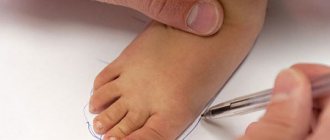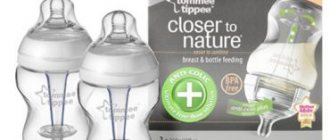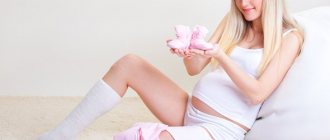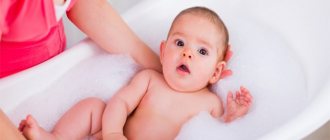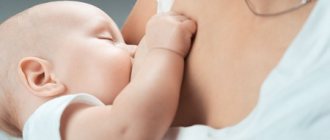5 years ago
Add a comment
- Anastasia
16,075 Views
The pacifier is rightfully considered a mother’s indispensable assistant. It satisfies the main reflex of a newborn - sucking. It also calms the baby, ensures his psychological comfort, and gives the mother a little rest. Choosing a pacifier for a newborn should be approached responsibly. Modern manufacturers offer a large selection of nipples. The main materials used in their manufacture are latex and silicone. Which pacifier is better and how to choose it correctly to provide the baby with maximum comfort and not spoil the bite?
At what age should you give a pacifier?
If you look at the markings on the packages, you will notice o, indicating that this product is intended for babies from the first days of life. Other models are also available: for older children (up to 1.5 years).
It is quite natural when a newly born toddler is given a pacifier, and he immediately “knows” what to do with it. The sucking reflex in infants is developed from birth and is prevalent in the first months.
As soon as the baby’s teeth appear and chewing functions begin to develop, the baby still does not refuse the pacifier. Although in this case there is a risk that the child may accidentally bite off a piece of the pacifier and swallow it.
Mothers rarely think about whether a pacifier is suitable for a newborn, considering its use as commonplace. Not every one of them knows why this attribute is actually needed.
Sucking reflex in newborns
While still in the mother's womb, with the help of an ultrasound examination you can make sure that the little one is actively sucking its thumb. Therefore, we can say with absolute certainty that the sucking reflex is innate. Nature made sure that when the baby was born, he already had the opportunity to get food through simple actions. If you put a breast on a toddler who is only a few hours old, he will swallow the nipple and begin to make active sucking movements in order to get enough of his mother’s milk. If this happens and there is no breast milk, the baby will be given something to eat from a bottle. Therefore, it is not surprising that the little one begins to suck a pacifier with ease. But the question arises: when is it time to accustom your baby to a pacifier and is there a need for it?
When is a pacifier needed?
Some women give the baby a pacifier immediately after feeding, hoping that the baby will fall asleep faster. Others use the product as a “calm down” when the little one starts crying. The main purpose of the pacifier, as Dr. Komarovsky says, is to prevent the baby from the habit of sucking fingers.
How to choose a stroller for a newborn in spring and summer
The reflex is most pronounced in the first 3 months, when the baby constantly makes sucking movements. At this stage, he cannot yet reach his mouth with his hands. Therefore, a pacifier should be introduced into everyday use from the moment the mother noticed that the little one began to suck his fingers.
Another world-famous pediatrician, Benjamin Spock, believes that if the baby is not given the opportunity to get enough of sucking for the first 3 months, then the unsatisfied need will accumulate, and one nipple will no longer be enough.
Note! If you give your baby a pacifier from the first weeks, then, having satisfied the sucking instinct in a timely manner, the child will then quickly refuse it. He won’t have any particular desire to constantly put his fingers in his mouth.
In addition to the points described, pacifiers for babies are useful in other situations:
- Sometimes a pacifier is the only way to calm a crying toddler. When switching energy from crying to sucking, the baby gradually moves to a calm rhythm and eventually falls asleep;
"Calm down" for the baby
- For colic, the pacifier helps cope with gas - in the process of sucking, intestinal motility is established;
- If you have to travel by plane, then this device will come in handy. Swallowing the saliva produced by sucking will reduce ear congestion that occurs during takeoff and landing.
For your information. Dentists categorically do not recommend using pacifiers, believing that they lead to deformation of developing teeth. If the little one uses his fingers instead of a pacifier, then the harm from this will be much greater.
Mom's doubts: will the baby be able to do without a mother substitute?
Mothers often have doubts about whether or not to give their newborn a pacifier. The following questions cause concern among women:
- Open mouth while walking in frosty air. The situation can be corrected by raising the baby's head. Modern strollers are equipped with this function. You can also use a thin newborn pillow or a folded diaper.
- Strong attachment to the child. Women prefer to give a pacifier to teach them to fall asleep without breastfeeding. But mother's milk contains substances that soothe and help you sleep. It is much easier and more comfortable for a baby to fall asleep with a breast than with a pacifier.
- The baby pushes away from the breast and protests, but takes the pacifier with pleasure. This sign indicates the beginning of the refusal of breastfeeding. If a woman has set herself the goal of transferring her baby to IV, then she is on the right track.
- Going to work requires the use of a mother substitute. Most often, women decide to continue their careers after the baby is six months old. At this age, the child is already able to remain without breastfeeding for up to 6 hours, receiving other food. Therefore, there is no need to accustom him to a pacifier.
- Harm from prolonged feedings and frequent regurgitation. Often women believe that the baby is spitting up from overeating. To avoid this, mothers offer a pacifier. But a little spitting up is normal. The causes of pathological regurgitation are improper attachment, an immature nervous system, or gastrointestinal diseases.
We recommend reading: The best premium strollers for newborns - photos of what to look for
Disadvantages of using pacifiers
Furniture for a newborn - which one to choose
To prevent the pacifier from becoming the cause of deformed teeth, you need to select the right model, and also take control over the use of the attribute. There are other points that are not in favor of the pacifier, you should pay attention to them:
- a baby who is constantly given a pacifier becomes lazy and sucks poorly; this negatively affects lactation;
- By giving the little one a pacifier for any reason, the mother thereby weakens the psycho-emotional contact with him;
- Constantly having a pacifier in the mouth negatively affects the mental development of the toddler (thinking and the ability to speak suffer).
When a baby gets used to sleeping with a pacifier, its loss will make the parents' lives hectic.
Material of manufacture
Let's look at common types of materials.
Latex
Made from rubber. It is flexible and elastic. Great for infants, premature and weak babies. But the material quickly becomes unusable. Products cannot be boiled; in the sun they acquire a dark tint, and with long-term use they become larger in size.
The material can also cause allergies because it contains protein molecules. Such products will need to be changed every month.
Silicone
They are made from synthetics. They handle boiling normally. They have no aroma and are transparent in color. Such nipples will not cause allergic reactions. But the material is denser and harder. Therefore, when teeth begin to emerge, it needs to be changed. Otherwise, the teeth will become deformed. The pacifier is thrown away and a new one is bought every 6 weeks.
Comparative characteristics: latex or silicone
It is impossible to answer unequivocally which baby nipple is better. Latex ones are softer, but not at all durable. Made from natural raw materials with a characteristic aroma. Babies don't always like this. Silicone does not smell. It is recommended for babies before teething begins.
Is it worth training
Which stroller to choose for a newborn in winter
Pacifiers for newborns are an optional item. You should not immediately introduce the baby to this attribute unless there is a justified reason for it. Many toddlers can easily do without a pacifier, thanks to the fact that their mother pays maximum attention to them.
But you shouldn’t completely abandon this product. There are various situations in life in which a pacifier will come in handy. The main thing is not to turn the attribute into a “panacea” for all problems.
Which pacifiers are better
Despite the debate about the pros and cons of using pacifiers, manufacturers continue to produce baby accessories. They differ in design appearance, dimensions, shapes, and material. Seeing such diversity, some parents are at a loss when deciding which nipples are best for newborns.
Criterias of choice
Having entered the children's department of a supermarket or pharmacy in order to buy a pacifier for their baby, some parents begin to look at bright, stylish models. At the same time, they forget to pay attention to other characteristics of the product.
The pacifier necessary for a newborn, which the baby will periodically take into the mouth, should not only satisfy the sucking reflex and improve intestinal motility, but also help in the formation of the bite, promoting the proper development of the facial muscles and dentition.
Geometric parameters
| Form | Peculiarities |
| Round | The classic is not inferior to its position, as it is closest in shape to the mother's nipple. Absolute symmetry allows the pacifier to fit comfortably in the oral cavity. True, there is an opinion that constant sucking of such a model will negatively affect the formation of the bite. |
| Anatomical | This model, like the round one, expands from the base to the end. But this product, which looks like a droplet, is considered more convenient - its shape does not put pressure on the jaws and gums. With such a pacifier there is no risk of developing malocclusion. |
| Orthodontic | The shape perfectly imitates the structure of a toddler's gums. The flattened side fits organically on the tongue, and the convex side merges with the palate. Thanks to this, the baby will not swallow air while sucking, which will save him from unpleasant colic. |
Orthodontic pacifier
There are various options among the models:
- “cherry” – recommended for large children;
- “butterfly” – preferably in a lying position;
- “heart” – created specifically for dentition correction.
When deciding which pacifier to choose for a newborn, parents should not rely only on common sense and their own preferences. The baby should choose the pacifier that seems most comfortable and “tastes” pleasant to him. Therefore, it is recommended to purchase several models and offer them to your baby.
Dimensions
When choosing a pacifier for your little one, take into account the baby's return. The size range offered by manufacturers is represented by 3 positions:
- from birth to 3 months;
- from 3 to 6 months;
- from six months to 1.5 years.
Note! There are separate models for premature babies and low birth weight babies (before 1750). They can be distinguished by their lightness, small size and pliability of the nipple.
Baby pacifier for premature babies
If the dimensions of the pacifier are chosen incorrectly, the product will cause discomfort to the baby:
- the small accessory will “get lost” in the baby’s mouth, causing irritation and negatively affecting the bite;
- nipples that are larger than the required size are inconvenient - the little one will choke on them.
When choosing the size of a model, it is worth taking into account that the age criterion is a conditional indicator. Some children develop more actively and look larger than their peers, while others, on the contrary, do not live up to conventional standards. Therefore, an individual approach is important here, taking into account the physiological characteristics of the baby.
Material
In the last century, this criterion was not considered when purchasing - all products were made of rubber. The modern market offers alternative options:
- Rubber nipples continue to be produced, as the classics are still in demand. Pacifiers do not deform when sterilized by boiling and are easy to clean. True, there are low-quality products that quickly break.
Interesting. If your baby is teething, a rubber pacifier will last at most for 3 weeks. In addition, in some children the material provokes the development of diathesis.
- Latex material is more attractive than rubber - elastic, pliable, soft. Pacifiers are suitable for both weak babies and those who actively suck. It is not recommended to use the products for a long time - after a month they become deformed and stick together with the inner walls.
Advice. This accessory should not be boiled; special products will be needed to care for the pacifier; they must be safe for a newborn. In hypersensitive children, latex can cause allergies.
- Silicone nipples are considered the safest for babies. They do not smell, do not have a specific color and are completely hypoallergenic. The material lends itself well to treatment with disinfectants; it can be washed and boiled. These nipples last longer than others without deformation - about 6 weeks.
Silicone pacifier
Despite the advantages of silicone pacifiers, they also have a disadvantage - due to the rigidity of the material, the baby may develop an incorrect bite. Therefore, it is better to use such pacifiers before the teething stage.
Additional criteria
Having studied the main factors on how to choose a pacifier for a newborn, it is recommended to pay attention to other points. Some consider them important; the baby’s comfort depends on such details:
- Mouthpiece. Its dimensions should be commensurate with the size of the face. The small size of the part will lead to the baby swallowing the pacifier into his mouth. Therefore, you should choose an accessory with a wide shield (but no more than 5 cm).
For your information. It is important that the part has a recess under the nose, then the nipple will not rub the delicate skin. The holes provide ventilation to avoid skin irritation.
- Ring. It has a functional meaning - with its help, the pacifier is fixed on a chain (so that the little one does not lose an important accessory if it falls out of his mouth). During sleep, the ring can disturb the baby (especially when he turns over on his tummy).
- Chain. Usually supplemented with a clothespin, which allows you to attach the accessory to the child’s clothing. This item is convenient to use while walking. Some parents treat the chain as a decorative element, and instead use laces or ribbons available in the household.
Pacifier chain
Some pacifier models are equipped with special caps that protect the product from contamination if the pacifier needs to be placed in a stroller or bag.
Basic selection rules
Before deciding on the material, you need to consider other factors:
- Baby's age.
- Pacifier size.
- Mouthpiece shape.
A size A pacifier is suitable for a baby 0-6 months old, a size B for a baby 6-18 months, and a size C for an older child.
Advice. Pediatricians recommend buying pacifiers in strict accordance with age. A pacifier that is too large fills the baby’s mouth, and a small one causes stronger compression of the gums. These factors can lead to subsequent malocclusion.
The mouthpiece (rim) must have holes for the child to breathe freely. They also serve as grooves for the drainage of saliva, the accumulation of which causes irritation of the delicate baby skin.
Which pacifier is better to choose?
When choosing a pacifier for a baby, a mother should also focus on the way she feeds her baby. In this case, the main criterion is the shape of the nipple.
With hepatitis B
Sometimes an accessory causes the baby to stop breastfeeding prematurely. Most often this happens when the child is given a round classic model, as close as possible to the mother's nipple.
Therefore, when deciding which pacifier to choose for a newborn while breastfeeding, they choose the orthodontic model. It has the ability to smooth out and gives the baby pleasure during the sucking process. Therefore, the child does not develop a negative perception of female breasts.
With IV
It is preferable to give a bottle-fed baby a different nipple than with breastfeeding. In this case, it is assumed that bottle-fed babies often have underdevelopment of the upper jaw. In order for the baby to work more actively with it while sucking, you should choose the anatomical option.
Still have questions? We answer!
Can a pacifier cause hiccups?
Hiccups develop from excessive swallowing of air while sucking on a breast or pacifier, so it is not directly related to the pacifier. If a child often hiccups, it means that he has not developed the technique of proper breastfeeding, and this point needs to be corrected together with the pediatrician. It is not recommended to use a pacifier until this symptom disappears.
Does a pacifier help with colic?
The implementation of the sucking reflex stimulates intestinal peristalsis, so gases are removed from the gastrointestinal tract faster, and the child experiences less pain.
Is it true that sucking a pacifier slows down speech development?
Some psychologists and doctors scare young parents with this information, but in fact there is no scientifically proven data on this statement. Speech therapy problems are not associated with the presence or absence of a pacifier in early childhood. However, using this accessory for too long can lead to malocclusion, which in turn causes problems with speech.
Does stomatitis occur from frequent use of a pacifier?
Inflammation of the oral mucosa develops due to the entry of harmful microbes. It may be associated with the pacifier if parents neglect to disinfect it regularly. With proper care of the product and its regular replacement, the risk of stomatitis is eliminated.
Is it possible to become psychologically dependent on a pacifier?
Yes, this problem occurs in children over 2 years old. In this case, the pacifier becomes the only way to calm down and achieve psychological comfort, and when trying to take it away, the baby throws a tantrum. To cope with a difficult situation, you need the help of a child psychologist.
Manufacturers of baby pacifiers
Having considered the shapes of products, the properties of the material, weighing all the pros and cons, many mothers try to choose a stylish, high-quality item. The rating of pacifiers produced for newborns will help them with this:
- Philips AVENT - thanks to reliability, quality, hypoallergenicity, bright design and reasonable price, this brand consistently holds its position in the list of popular models.
- Chicco - Italian manufacturers take into account the physiology of babies, so they produce only high-quality products.
- Bibi products have been popular for 75 years, which already says a lot in their favor.
Chicco pacifier
It is also recommended to pay attention to Brown, Canpol Babies, Pigeon and a number of other brands known throughout the world. The success of their popularity lies in the use of high-quality, safe materials and high technologies.
Rules for using a baby pacifier
It’s not enough to choose a pacifier for your baby; you also need to use it correctly, following these recommendations:
- Having brought a pacifier into the house, it is first washed with soap, then kept for several minutes in an acidic solution (half water and vinegar), washed again, dried and only then given to the baby;
- the pacifier should always be clean and stored in a special box;
Important! You should not lick the pacifier or give it to your baby if he has dropped it.
- if a baby has lost its pacifier in a dream and is not looking for it, you should not return the pacifier to the mouth;
- It is advisable to have several nipples of the same model in stock (in case one gets damaged).
Recommendation. When the baby has teeth, it is recommended to gradually wean the baby off the pacifier. Now he not only sucks it, but also chews it, which makes the situation dangerous to health.
A pacifier for a baby should not become a mandatory 24-hour attribute. In order for the accessory to be beneficial in the development of the baby, before purchasing, you should decide which is the best pacifier for a newborn, taking into account its physiological characteristics.
